Learn more about the different types of pedestrian crossings in Edmonton.
Pedestrian control devices, including crossings and traffic signals, help protect people when they cross the street.
Pedestrian Right of Way
Not all crossings are marked, but the Traffic Safety Act stipulates the rules of pedestrian safety should be followed at all intersections.
- When pedestrians indicate their intention to cross the street, vehicles must stop before the crossing and allow them to cross
- When a pedestrian has entered a marked or unmarked crossing, drivers must yield the right-of-way
- When stopping for a pedestrian at a crossing, drivers should stop their vehicles far enough back, about two to three car lengths, so traffic in other lanes will be able to see the pedestrian and have time to stop
Drivers who fail to yield to pedestrians can be ticketed and fined $575.
Pedestrian Traffic Control
An unmarked crossing includes any intersection connecting sidewalks, curbs or edges of the road.

Marked with two parallel lines, these are used where vehicle volumes are relatively light and the posted speed limit is less than 60 km/hr.
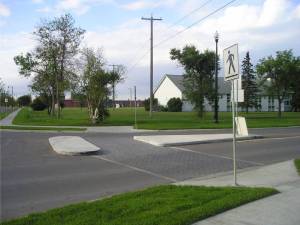
“Zebra” marked crossings are generally used at mid-block and right-turn cut-off crossing points and non-standard or off-set intersections where drivers may not expect to see pedestrians.
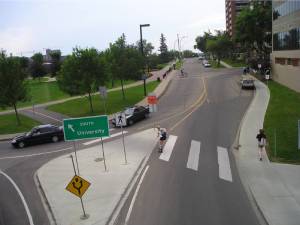
While active, amber traffic lights flash to warn drivers they must slow to the indicated speed and stop for pedestrians.
This signal enhances pedestrian visibility and safety in areas with moderate to high traffic volumes.
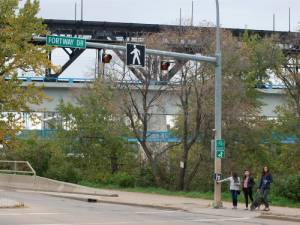
Pedestrian-activated signals are traditional green/amber/red traffic lights with a pedestrian-activated button on the pedestal. Once activated, vehicles must come to a full stop.
This signal may be coordinated with adjacent traffic signals so the red light may not activate immediately. This device is the highest level of protection installed for pedestrians. It is used on arterial roadways where the posted speed is 60 km/hr or higher.
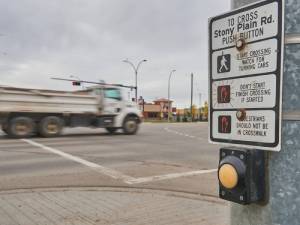
Pedestrian countdown signals supplement the walk person, flashing hand and solid hand pedestrian traffic signals. They are used where there is heavy pedestrian and motorist traffic.
Countdown signals let pedestrians know how much time they have to clear the intersection. Pedestrians should not enter the crossing after the signal has started counting down.
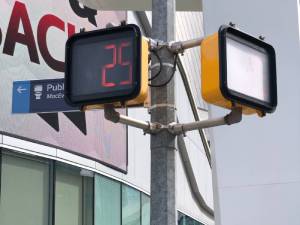
Audible signals help guide people with low or limited loss of vision across the road. The City coordinates locations for audible signals with The Canadian National Institute for the Blind (CNIB). These signals are used at signalized intersections where the geometry is unusual or there are high volumes of turning vehicles.
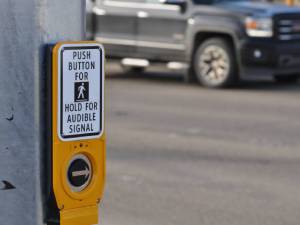
Pedestrian Scrambles
Many cities around the world use scrambles to provide safe and accessible crossings in high-pedestrian areas. They are an effective tool for increasing safety and livability on our streets.
How To Use Pedestrian Scrambles
At a pedestrian scramble, all vehicles stop, allowing pedestrians to cross the intersection in every direction, including diagonally, at the same time.
On Your Feet
- Cross on the 'Walk' signal in any direction, including diagonally
- Wait while vehicles are moving
In Your Vehicle
- Turn right or left on the 'Green' light
- Wait while pedestrians are moving
- 104 Avenue and 104 Street
- 104 Avenue and 102 Street
- 103 Avenue and 103 Street
- Jasper Avenue and 104 Street
- Whyte Avenue and 104 Street (Calgary Trail)
- Whyte Avenue and 105 Street
- Whyte Avenue and Gateway Boulevard
- 105 Avenue and 105 Street (MacEwan)
- Jasper Avenue and Rice Howard Way (100A Street)
- Stony Plain Road and 152 Street
Frequently Asked Questions
Learn more about pedestrian crossings and how the City decides what is done for pedestrian safety.
This type of left-turn phase, known as "protected-prohibited" is designed to separate left-turning traffic from opposing through traffic. Even if an acceptable gap exists in the oncoming through traffic, vehicles are required to wait for the green arrow in order to turn left.
"Protected-prohibited" phases are currently operating in Edmonton at intersections such as but not limited to Yellowhead Trail & 149th Street and 87th Avenue & 170th Street. These turn phases have been implemented for safety-related reasons where double left-turn lanes exist, where there are a high number of left-turning accidents, where turning vehicles cross LRT tracks, or where other safety issues are present.
For safety-related reasons, the majority of traffic signals in the City are not put on flash at night. A flashing traffic signal may cause driver confusion, provides no pedestrian protection and may increase the incidences of "drag racing".
The City does however have vehicle-actuated traffic signals at many intersections in Edmonton. At these signals, the light remains green for the main street traffic until side-street traffic is detected. This operation results in lower overall vehicle delay.
The City has adopted the use of pedestrian countdown signals as standard devices at signalized intersections. These devices are installed at new traffic signals or retrofitted at existing traffic signals as part of a multitude of renewal programs. Drivers should use the amber signal indication as an indication of an impending change in right-of-way.
Although pedestrian signals, including the countdown timers, are designed for pedestrians, not vehicles, drivers do sometimes look at these lights as an advance-warning tool. Drivers should use the amber signal as an indication of an impending change in right-of-way.
The City follows a standard guideline in its design of amber and red periods for traffic signals. The amber period provides time for drivers to react to a signal change and decide whether to stop or to safely proceed through an intersection. The red period, where all directions face a red display, provides additional time for vehicles already in an intersection to clear before opposing traffic enters.
The walk light indicates when it is safe for pedestrians to begin crossing. In Edmonton, the duration of the walk light may be as short as seven seconds but can often be greater when the duration of the green light for vehicles is relatively long.
The walk light display is followed by a red flashing hand known as the "clearance phase". The duration of the clearance phase is dependent on the width of the road being crossed.
If a pedestrian steps off the curb and begins crossing just as the red hand starts flashing, there should be adequate time for the pedestrian to finish crossing. If the flashing red hand appears when you are only partway across the street, you should continue crossing as there is still adequate time to clear the intersection.
Once the flashing red hand is displayed, it is not recommended for pedestrians to begin crossing as there may not be sufficient time remaining to cross the street safely. Pedestrians should then wait for the next walk light to cross.
Audible signals are provided at key signalized intersections to assist those with low or limited loss of vision to cross the roadway. The City coordinates locations for audible signals in conjunction with the Canadian National Institute for the Blind (CNIB).
The CNIB encourages these individuals to cross based on traffic noise as opposed to relying on audible signals. These signals are generally used only in special circumstances such as when the intersection geometry is unusual or vehicle-turning volumes are high.
"Walk/Don't Walk" signals that are automatically displayed are installed at intersections where the duration of the green light required for vehicle traffic in a given direction is greater than the required pedestrian crossing time.
At intersections where the required minimum vehicle green time is less than the pedestrian crossing time, pedestrian push buttons are installed. If the pedestrian button is not activated, the duration of the green light can be extended for the high-volume vehicle movements. This operation allows for reduced delays to traffic.


